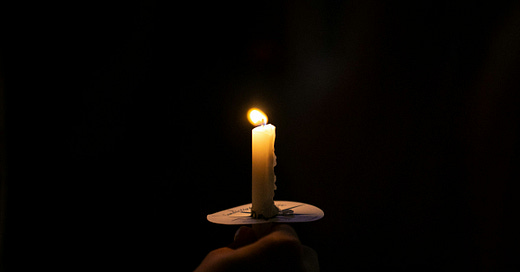Sivan 5784: The Origins of Tikkun Leil Shavuot
🌃 The Kabbalistic practice of staying awake late into the night of the holiday of Shavuot and studying Torah has its roots in the Zohar, but was developed in Tzfat (Safed) in the sixteenth century.
Audio
Find an audio version of this newsletter here.
In this issue:
In our days, a once-esoteric ritual of staying awake during the night of the holiday of Shavuot has become ubiquitous in synagogues and homes across the Jewish world. Over coffee and cheesecake, many Jews study Torah, whether using prescribed texts, attending shiurim (lectures), or learning what most moves them. Like so many of the rituals that color modern Jewish religious life, this one has its roots in Sefer ha-Zohar, the core text of the Kabbala, but in the form developed in the unique mystical fellowship circles of sixteenth-century Tzfat (Safed).
Zoharic Foundations
Sefer ha-Zohar, the foundational text of Kabbala which surfaced in late thirteenth-century Spain, contains clear antecedents of the ritual we recognize today as Tikkun Leil Shavuot. It speaks of an ancient, pious practice to stay up Shavuot night and learn Torah.
חֲסִידֵי קַדְמָאֵי לָא הֲווֹ נָיְימֵי בְּהַאי לֵילְיָא, וַהֲווּ לָעָאן בְּאוֹרַיְיתָא, וְאַמְרֵי, נֵיתֵי לְאַחֲסָנָא יְרוּתָא קַדִּישָׁא, לָן, וְלִבְנָן,בִּתְרֵין עָלְמִין. וְהַהוּא לֵילְיָא כְּנֶסֶת יִשְׂרָאֵל אִתְעַטְּרָא עָלַיְיהוּ, וְאַתְיָיא לְאִזְדַּוְּוגָא בֵּיהּ בְּמַלְכָּא, וְתַרְוַויְיהוּ מִתְעַטְּרֵי עַל רֵישַׁיְיהוּ, דְּאִינּוּן דְּזַכָּאן לְהָכִי. רַבִּי שִׁמְעוֹן הָכִי אָמַר, בְּשַׁעֲתָא דְּמִתְכַּנְשֵׁי חַבְרַיָּיא בְּהַאי לֵילְיָא לְגַבֵּיהּ, נֵיתֵי לְתַקְּנָא תַּכְשִׁיטֵי כַּלָּה, בְּגִין דְּתִשְׁתְּכַח לְמָחָר בְּתַכְשִׁיטָהָא, וְתִקוּנָהָא, לְגַבֵּי מַלְכָּא כַּדְקָא יָאוּת.
The ancient pious ones would not sleep on that night [Shavuot] but would study the Torah and say, “Let us take hold of the inheritance sacred to us and our children, in both worlds.” On that night, the Congregation of Israel (Knesset Yisrael) adorns itself, and comes to conjoin with the King, both of them with crowns on their heads, as they merit this. R. Shimon would say at the time that his companions would gather on that night, “Let us come to correct (le-takna) the jewelry of the bride so that tomorrow she will be found with her jewelry, prepared for the King, as is fitting.”
As is so typical of Zoharic imagery, this passage uses the metaphor of a bride, representing the Jewish people, uniting in a marriage ceremony with the groom—G-d. The tikkun, or correction, effected by the bride (that is, Knesset Yisrael) is one of becoming suitable to meet with her Groom. It consists of adornment, here, by means of the Torah.
Keep reading with a 7-day free trial
Subscribe to Stories from Jewish History to keep reading this post and get 7 days of free access to the full post archives.





